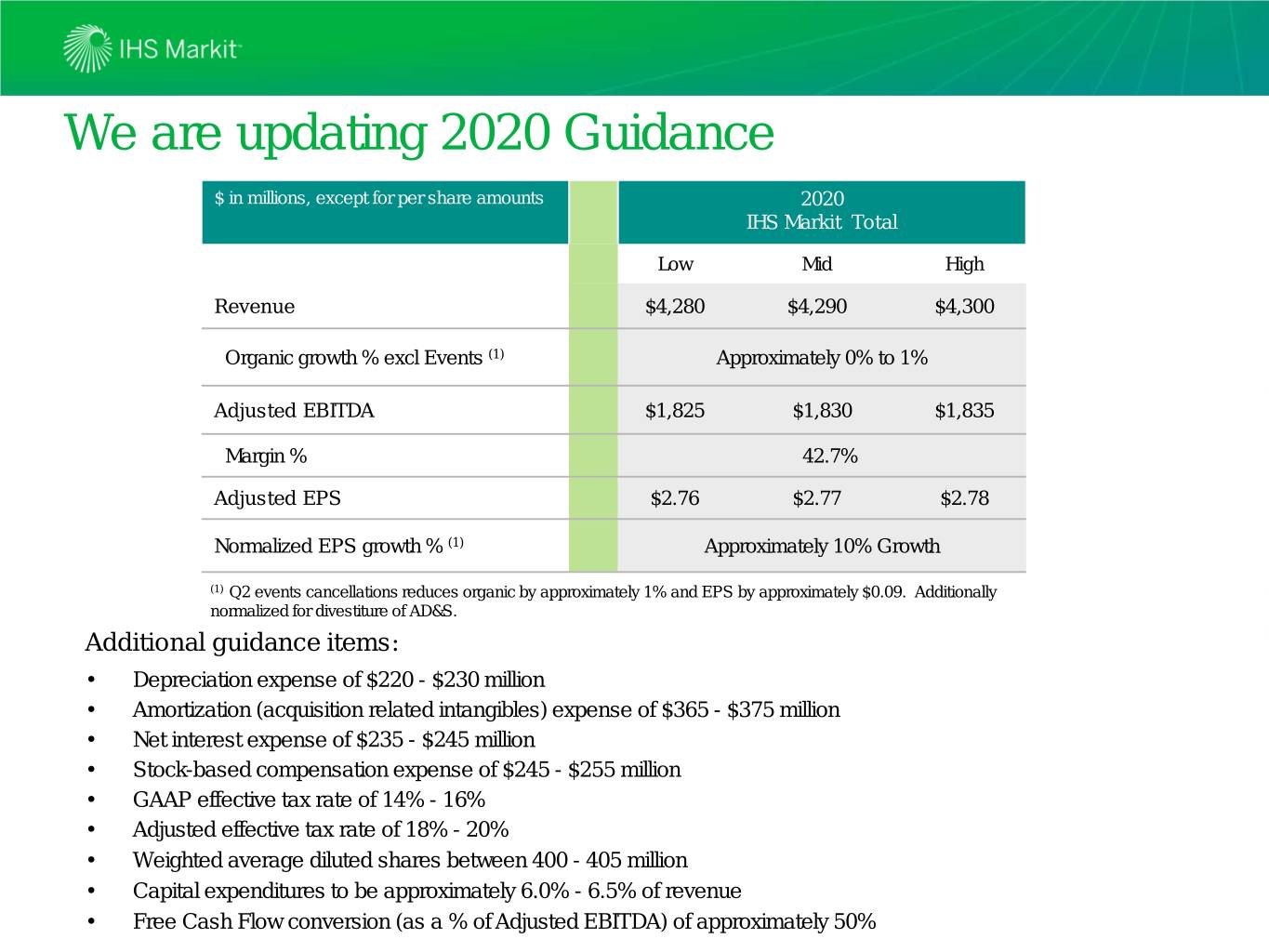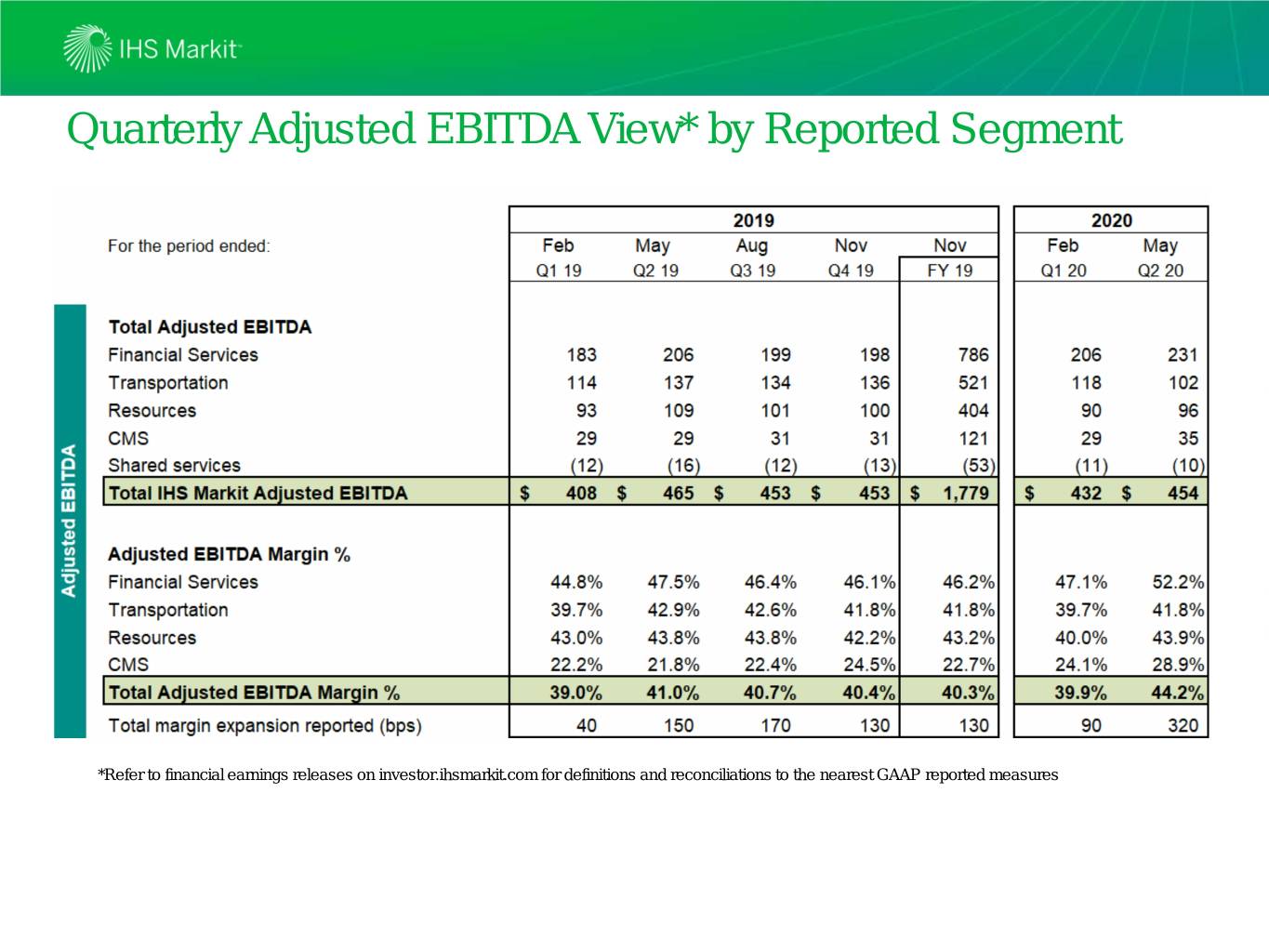Attached files
| file | filename |
|---|---|
| EX-99.1 - MEDIA RELEASE - IHS Markit Ltd. | ex991q220.htm |
| 8-K - 8-K - IHS Markit Ltd. | q2-20earningsrelease.htm |

Q2 2020 Earnings Supplemental Financials June 23, 2020

Forward-looking statements This presentation contains “forward-looking statements” as defined in the Private Securities Litigation Reform Act of 1995. These statements, which express management’s current views concerning future business, events, trends, contingencies, financial performance, or financial condition, appear at various places in this communication and use words like “aim,” “anticipate,” “assume,” “believe,” “continue,” “could,” “estimate,” “expect,” “forecast,” “future,” “goal,” “intend,” “likely,” “may,” “might,” “plan,” “potential,” “predict,” “project,” “see,” “seek,” “should,” “strategy,” “strive,” “target,” “will,” and “would” and similar expressions, and variations or negatives of these words. Examples of forward-looking statements include, among others, statements we make regarding: guidance and predictions relating to expected operating results, such as revenue growth and earnings; strategic actions such as acquisitions, joint ventures, and dispositions, the anticipated benefits therefrom, and our success in integrating acquired businesses; anticipated levels of capital expenditures in future periods; anticipated levels of indebtedness, capital allocation, dividends, and share repurchases in future periods; our belief that we have sufficient liquidity to fund our ongoing business operations; expectations of the effect on our financial condition of claims, litigation, environmental costs, contingent liabilities, and governmental and regulatory investigations and proceedings; and our strategy for customer retention, growth, product development, market position, financial results, and reserves. Forward-looking statements are neither historical facts nor assurances of future performance. Instead, they are based only on management’s current beliefs, expectations, and assumptions regarding the future of our business, future plans and strategies, projections, anticipated events and trends, the economy, and other future conditions. Because forward-looking statements relate to the future, they are subject to inherent uncertainties, risks, and changes in circumstances that are difficult to predict and many of which are outside of our control. Important factors that could cause our actual results and financial condition to differ materially from those indicated in the forward- looking statements are more fully discussed under the caption “Risk Factors” in our Annual Report on Form 10-K, along with our other filings with the U.S. Securities and Exchange Commission (“SEC”). However, those factors should not be considered to be a complete statement of all potential risks and uncertainties. Unlisted factors may present significant additional obstacles to the realization of forward-looking statements. Consequences of material differences in results as compared with those anticipated in the forward-looking statements could include, among other things, business disruption, operational problems, financial loss, legal liability to third parties and similar risks, any of which could have a material adverse effect on our consolidated financial condition, results of operations, credit rating, or liquidity. Therefore, you should not rely on any of these forward-looking statements. Any forward-looking statement made by us in this communication is based only on information currently available to our management and speaks only as of the date of this communication. We do not assume any obligation to publicly provide revisions or updates to any forward-looking statements, whether as a result of new information, future developments or otherwise, should circumstances change, except as otherwise required by securities and other applicable laws. Please consult our public filings with the SEC or on our website at investor.ihsmarkit.com. Non-GAAP measures Non-GAAP financial information is presented only as a supplement to IHS Markit’s financial information based on U.S. generally accepted accounting principles (“GAAP”). Non-GAAP financial information is provided to enhance the reader’s understanding of IHS Markit’s financial performance, but none of these non-GAAP financial measures are recognized terms under GAAP and should not be considered in isolation from, or as a substitute for, financial measures calculated in accordance with GAAP. Definitions of IHS Markit non-GAAP measures and reconciliations to the most directly comparable GAAP measures are provided within the schedules attached to IHS Markit’s quarterly earnings releases on the Investor Relations section of the company’s website (investor.ihsmarkit.com). This presentation also includes certain forward-looking non-GAAP financial measures. IHS Markit is unable to present a reconciliation of this forward looking non-GAAP financial information because management cannot reliably predict all of the necessary components of such measures. Accordingly, investors are cautioned not to place undue reliance on this information. IHS Markit uses non-GAAP measures in its operational and financial decision making. IHS Markit believes that such measures allow it to focus on what it deems to be more a reliable indicator of ongoing operating performance and its ability to generate cash flow from operations. IHS Markit also believes that investors may find these non-GAAP financial measures useful for the same reasons, although investors are cautioned that non-GAAP financial measures are not a substitute for GAAP financial measures or disclosures. None of these non-GAAP financial measures are recognized terms under GAAP and do not purport to be an alternative to any other GAAP measure. Non-GAAP measures are frequently used by securities analysts, investors and other interested parties in their evaluation of companies comparable to IHS Markit, many of which present non- GAAP measures when reporting their results. These measures can be useful in evaluating IHS Markit’s performance against its peer companies because IHS Markit believes the measures provide users with valuable insight into key components of GAAP financial disclosures. However, non-GAAP measures have limitations as an analytical tool. Because not all companies use identical calculations, IHS Markit’s presentation of non-GAAP financial measures may not be comparable to other similarly titled measures of other companies. They are not presentations made in accordance with GAAP, are not measures of financial condition or liquidity and should not be considered as an alternative to profit or loss for the period determined in accordance with GAAP or operating cash flows determined in accordance with GAAP. As a result, these performance measures should not be considered in isolation from, or as a substitute analysis for, results of operations as determined in accordance with GAAP.

We are updating 2020 Guidance $ in millions, except for per share amounts 2020 IHS Markit Total Low Mid High Revenue $4,280 $4,290 $4,300 Organic growth % excl Events (1) Approximately 0% to 1% Adjusted EBITDA $1,825 $1,830 $1,835 Margin % 42.7% Adjusted EPS $2.76 $2.77 $2.78 Normalized EPS growth % (1) Approximately 10% Growth (1) Q2 events cancellations reduces organic by approximately 1% and EPS by approximately $0.09. Additionally normalized for divestiture of AD&S. Additional guidance items: • Depreciation expense of $220 - $230 million • Amortization (acquisition related intangibles) expense of $365 - $375 million • Net interest expense of $235 - $245 million • Stock-based compensation expense of $245 - $255 million • GAAP effective tax rate of 14% - 16% • Adjusted effective tax rate of 18% - 20% • Weighted average diluted shares between 400 - 405 million • Capital expenditures to be approximately 6.0% - 6.5% of revenue • Free Cash Flow conversion (as a % of Adjusted EBITDA) of approximately 50%

Quarterly Revenue by Reported Segment

Quarterly Organic Growth (1) Q3 19 and FY 19 Total Organic Growth % includes Ipreo for one month and four months respectively (2) Q2 20 Transportation non-recurring organic revenue growth including impact of cancelled events is -37%, total organic revenue growth is -18%. (3) Q2 20 Resources non-recurring organic revenue growth including impact of cancelled events is -62% and total organic revenue growth is -14%. (4) Q2 20 total non-recurring organic revenue growth including impact of cancelled events is -40% and total organic revenue growth is -7%.

Quarterly Financial Services Revenue (1) Q3 19, FY 19 Organic Growth % includes Ipreo for one month and four months respectively. Approximately 60% of Ipreo revenue is now reported in Solutions and the remainder in Information. 2019 Revenue and Q3 19 and Q4 19 Organic Growth % has been updated to include Ipreo within Solutions and Information. 2019 FY Revenue Ipreo was $345. In the table above it represents approximately 30% of Solutions revenue and 17% of Information revenue.

Quarterly Adjusted EBITDA View* by Reported Segment *Refer to financial earnings releases on investor.ihsmarkit.com for definitions and reconciliations to the nearest GAAP reported measures

2021 forward range Strong growth and profit delivery 2020 Guidance Midpoint 2021 Range ($'s millions except per share amounts) Revenue 4,290 4,575 4,675 Organic Growth (from 2020 midpoint) 7% 9% Financial Services 6 to 8% Transportation 14 to 16% Resources down 2% to up 2% CMS mid single digits Total Expense 2,460 2,575 2,645 Adjusted EBITDA 1,830 2,000 2,030 Adjusted EBITDA Growth (from 2020 midpoint) 9% 11% Adjusted EPS 2.77 3.14 3.19 Adjusted EPS Growth Reported (from 2020 midpoint) 13% 15% Adjusted EPS Growth with Events Cancellation (from 2020 midpoint) (1) 10% 12% (1) Comparison is adjusted for 2020 events cancellation ($0.09 EPS) Assumptions: • Financial Services returns to longer-term organic revenue growth range • Transportation growth in high single digits plus favorable year-over-year benefit due to Q2 2020 dealer price concessions • Resources continued Downstream strength and conservative resumption of events somewhat offset by lower Upstream subs revenue as a result of lower 2020 bookings
